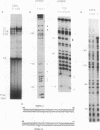Abstract
The mts1 gene is specifically expressed in certain metastatic tumors but not in their nonmetastatic counterparts. It is also expressed in several normal cell and tissue types that exhibit the ability to be motile. The gene was cloned from both mouse and human sources and the 5' flanking regions were sequenced. The sequencing data revealed a 135-base-pair region of high homology between the mouse and human mts1 gene. This homology was observed in the vicinity of the TATA box. The 5' region of the mts1 gene was also observed to have a high degree of homology to some known promoter and enhancer sequences. To determine the role this region plays in regulating the transcription of mts1, promoter analysis was performed. Sixteen constructs were prepared in which the chloramphenicol acetyltransferase gene was fused to different regions of the mouse mts1 promoter. These constructs were analyzed in transient transfection assays in two related cell lines derived from mouse mammary adenosarcomas: CSML-0, a nonmetastatic cell line with low levels of mts1 expression, and CSML-100, a metastatic cell line with high levels of mts1 expression. Results of our transient transfection assays in conjunction with results obtained from in vitro and in vivo footprinting of the promoter region show no evidence of cis-acting control elements important for the transcriptional regulation of mts1 in these cell lines. A few nucleotides upstream of the TATA box are sufficient for maximal levels of mts1 transcription. Because no cis-acting control elements were found, restriction of mts1 transcription in CSML-0 cells must exist on some other level. mts1 was found to be hypermethylated in CSML-0 cells but not in CSML-100 cells. The possible role of methylation in progression of the nonmetastatic CSML-0 adenosarcoma cell line toward the metastatic CSML-100 adenosarcoma cell line is discussed.
Full text
PDF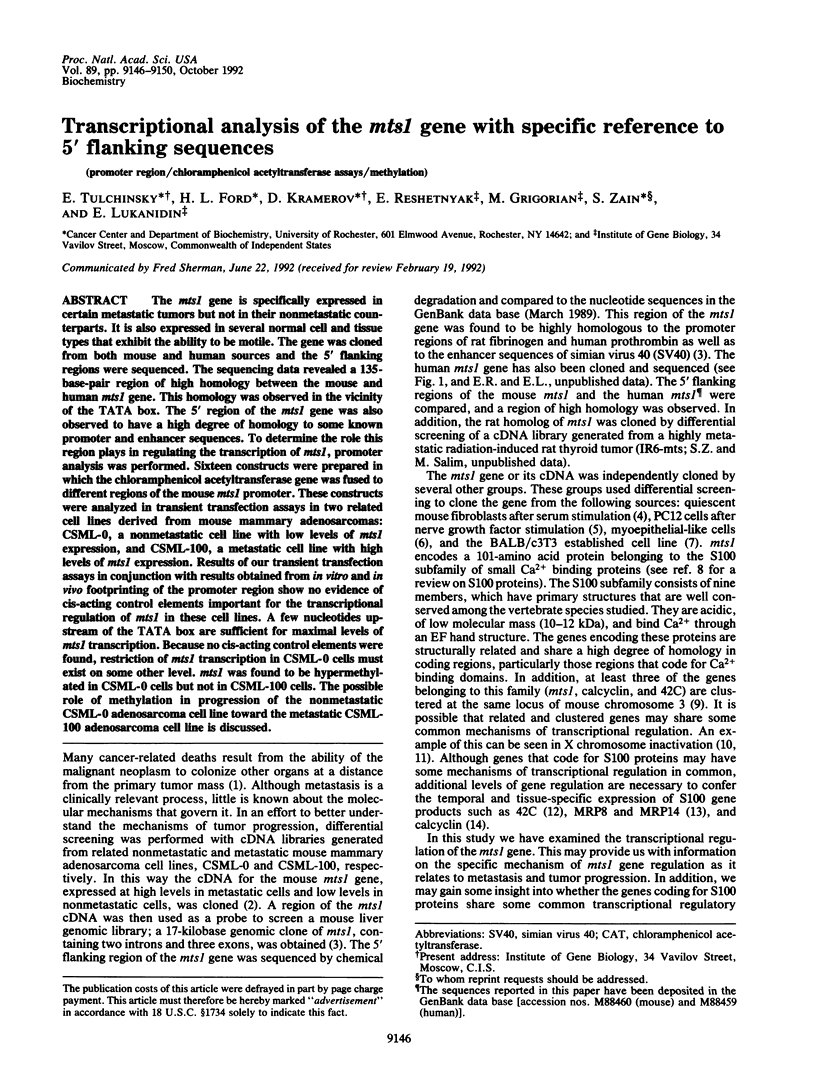
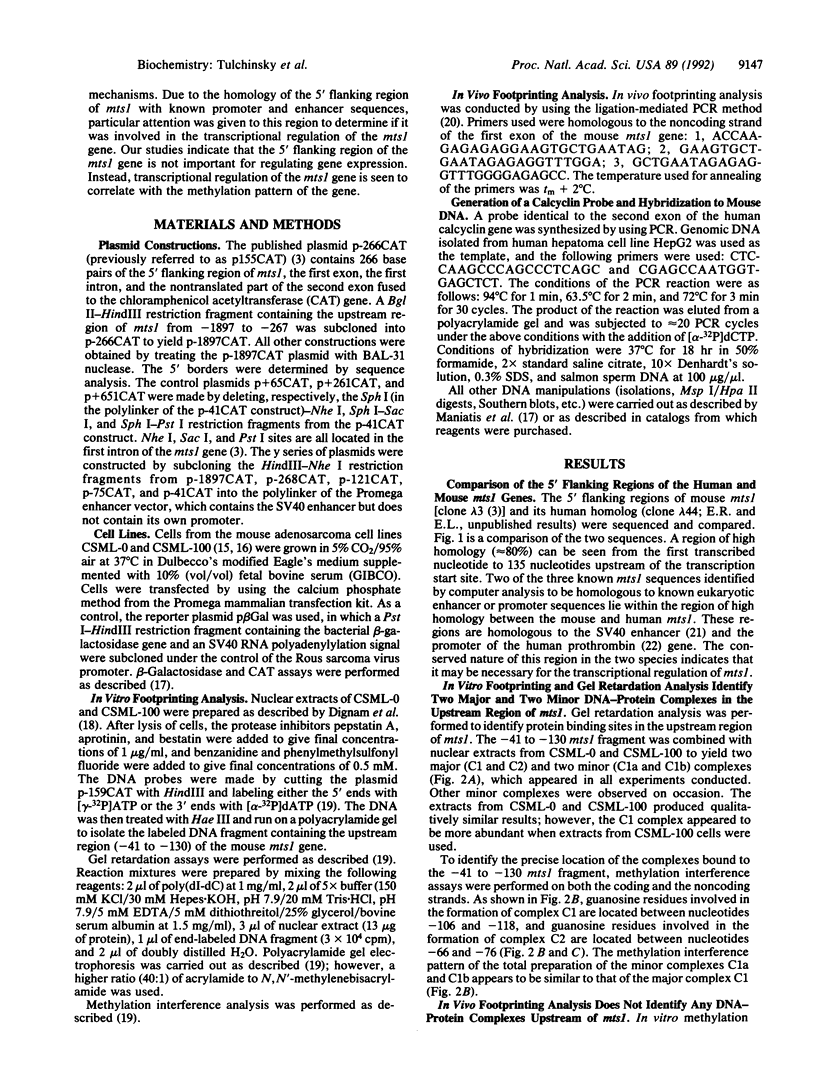
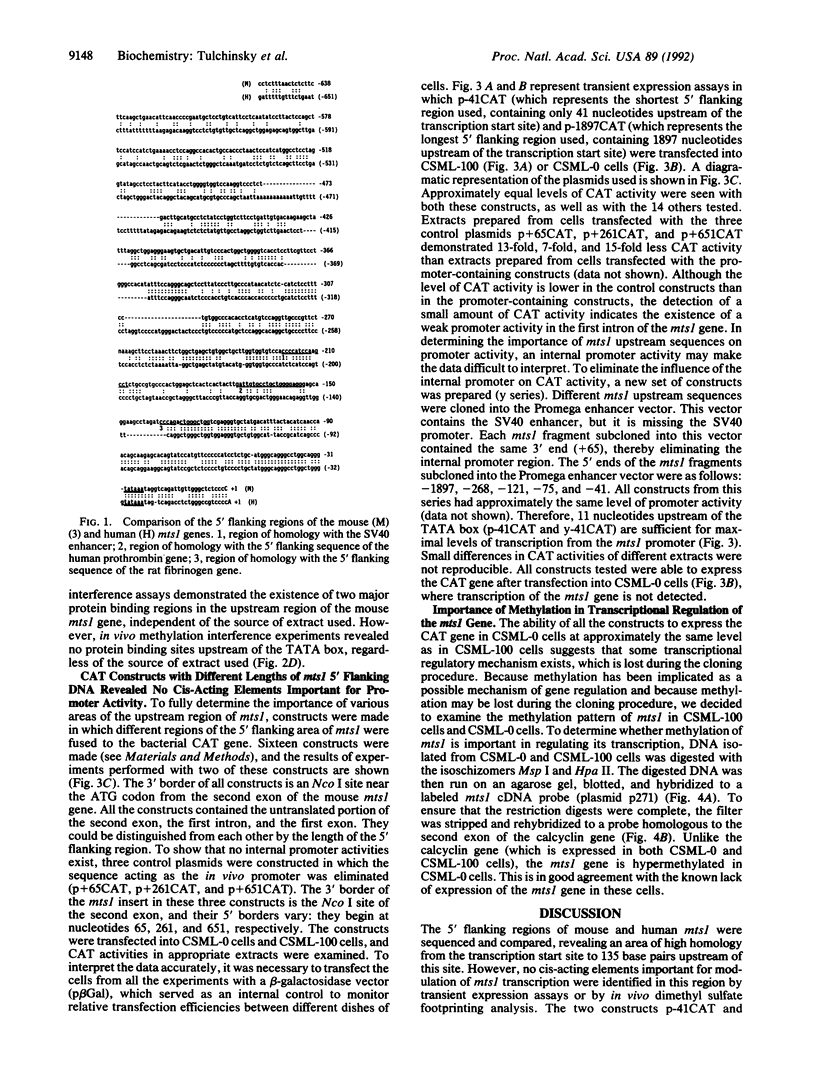
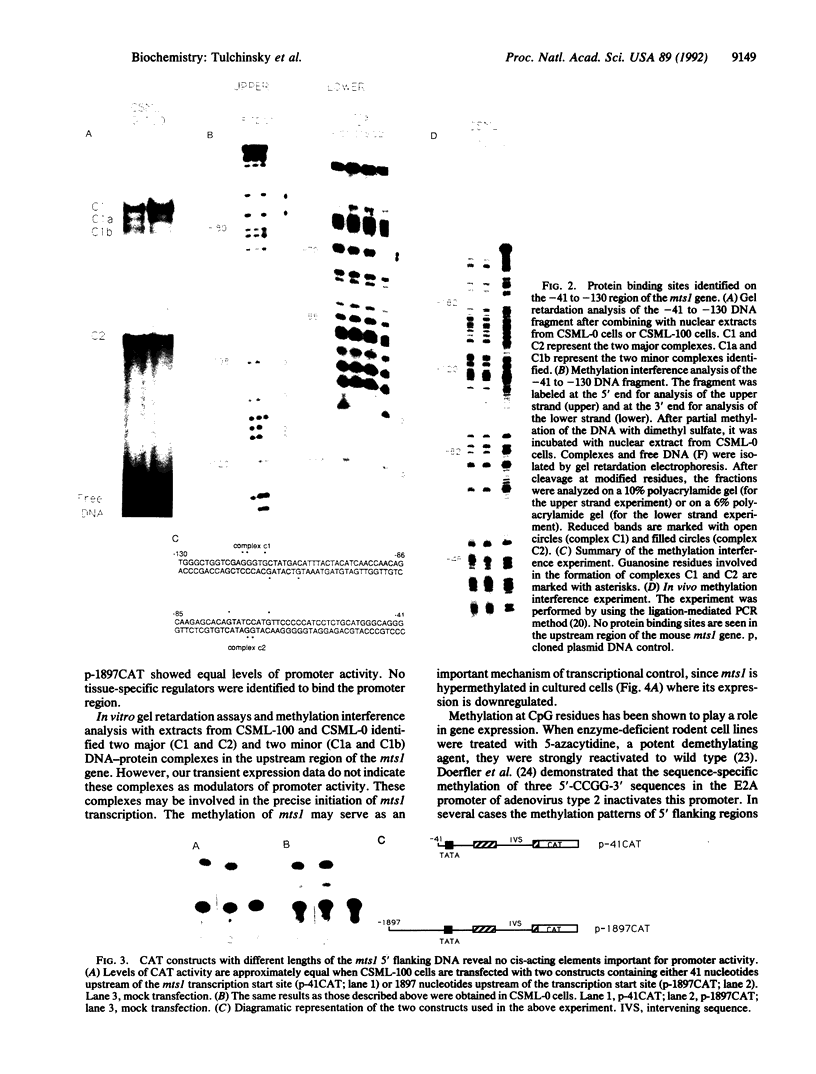
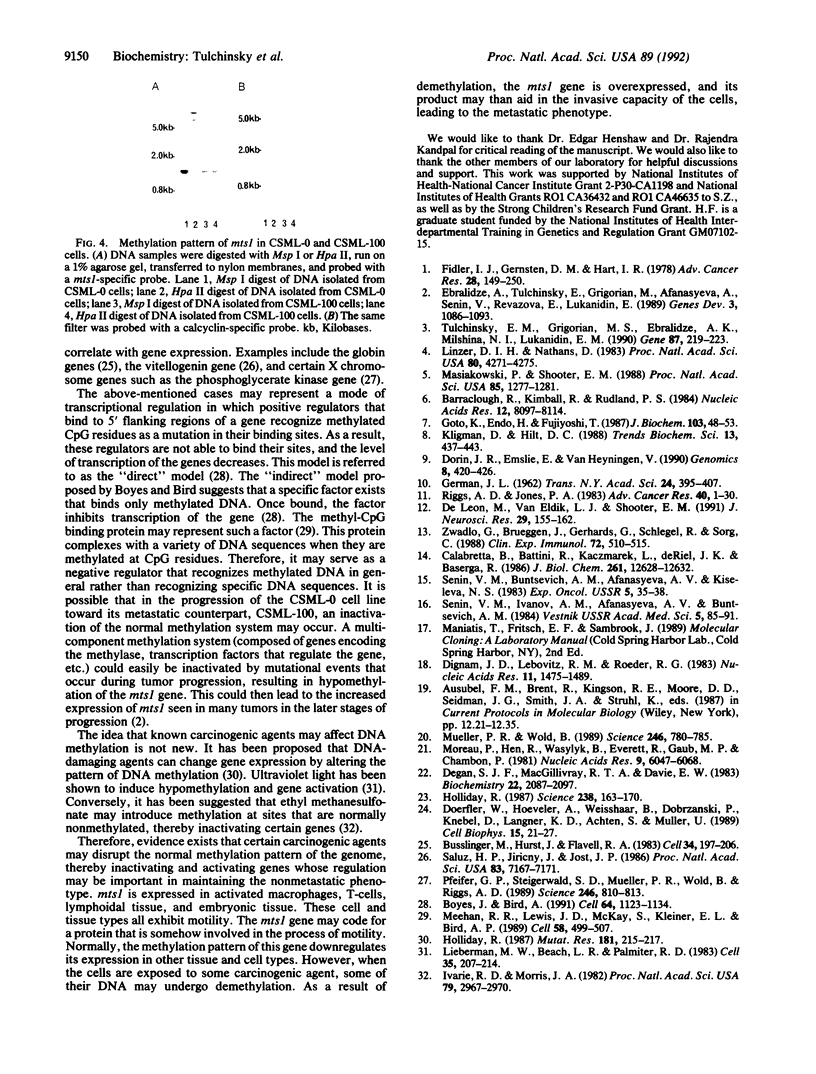
Images in this article
Selected References
These references are in PubMed. This may not be the complete list of references from this article.
- Barraclough R., Kimbell R., Rudland P. S. Increased abundance of a normal cell mRNA sequence accompanies the conversion of rat mammary cuboidal epithelial cells to elongated myoepithelial-like cells in culture. Nucleic Acids Res. 1984 Nov 12;12(21):8097–8114. doi: 10.1093/nar/12.21.8097. [DOI] [PMC free article] [PubMed] [Google Scholar]
- Boyes J., Bird A. DNA methylation inhibits transcription indirectly via a methyl-CpG binding protein. Cell. 1991 Mar 22;64(6):1123–1134. doi: 10.1016/0092-8674(91)90267-3. [DOI] [PubMed] [Google Scholar]
- Busslinger M., Hurst J., Flavell R. A. DNA methylation and the regulation of globin gene expression. Cell. 1983 Aug;34(1):197–206. doi: 10.1016/0092-8674(83)90150-2. [DOI] [PubMed] [Google Scholar]
- Calabretta B., Battini R., Kaczmarek L., de Riel J. K., Baserga R. Molecular cloning of the cDNA for a growth factor-inducible gene with strong homology to S-100, a calcium-binding protein. J Biol Chem. 1986 Sep 25;261(27):12628–12632. [PubMed] [Google Scholar]
- De León M., Van Eldik L. J., Shooter E. M. Differential regulation of S100 beta and mRNAs coding for S100-like proteins (42A and 42C) during development and after lesion of rat sciatic nerve. J Neurosci Res. 1991 Jun;29(2):155–162. doi: 10.1002/jnr.490290204. [DOI] [PubMed] [Google Scholar]
- Degen S. J., MacGillivray R. T., Davie E. W. Characterization of the complementary deoxyribonucleic acid and gene coding for human prothrombin. Biochemistry. 1983 Apr 26;22(9):2087–2097. doi: 10.1021/bi00278a008. [DOI] [PubMed] [Google Scholar]
- Dignam J. D., Lebovitz R. M., Roeder R. G. Accurate transcription initiation by RNA polymerase II in a soluble extract from isolated mammalian nuclei. Nucleic Acids Res. 1983 Mar 11;11(5):1475–1489. doi: 10.1093/nar/11.5.1475. [DOI] [PMC free article] [PubMed] [Google Scholar]
- Doerfler W., Hoeveler A., Weisshaar B., Dobrzanski P., Knebel D., Langner K. D., Achten S., Müller U. Promoter inactivation or inhibition by sequence-specific methylation and mechanisms of reactivation. Cell Biophys. 1989 Aug-Oct;15(1-2):21–27. doi: 10.1007/BF02991576. [DOI] [PubMed] [Google Scholar]
- Dorin J. R., Emslie E., van Heyningen V. Related calcium-binding proteins map to the same subregion of chromosome 1q and to an extended region of synteny on mouse chromosome 3. Genomics. 1990 Nov;8(3):420–426. doi: 10.1016/0888-7543(90)90027-r. [DOI] [PubMed] [Google Scholar]
- Ebralidze A., Tulchinsky E., Grigorian M., Afanasyeva A., Senin V., Revazova E., Lukanidin E. Isolation and characterization of a gene specifically expressed in different metastatic cells and whose deduced gene product has a high degree of homology to a Ca2+-binding protein family. Genes Dev. 1989 Jul;3(7):1086–1093. doi: 10.1101/gad.3.7.1086. [DOI] [PubMed] [Google Scholar]
- Fidler I. J., Gersten D. M., Hart I. R. The biology of cancer invasion and metastasis. Adv Cancer Res. 1978;28:149–250. doi: 10.1016/s0065-230x(08)60648-x. [DOI] [PubMed] [Google Scholar]
- Goto K., Endo H., Fujiyoshi T. Cloning of the sequences expressed abundantly in established cell lines: identification of a cDNA clone highly homologous to S-100, a calcium binding protein. J Biochem. 1988 Jan;103(1):48–53. doi: 10.1093/oxfordjournals.jbchem.a122237. [DOI] [PubMed] [Google Scholar]
- Holliday R. DNA methylation and epigenetic defects in carcinogenesis. Mutat Res. 1987 Dec;181(2):215–217. doi: 10.1016/0027-5107(87)90098-4. [DOI] [PubMed] [Google Scholar]
- Holliday R. The inheritance of epigenetic defects. Science. 1987 Oct 9;238(4824):163–170. doi: 10.1126/science.3310230. [DOI] [PubMed] [Google Scholar]
- Ivarie R. D., Morris J. A. Induction of prolactin-deficient variants of GH3 rat pituitary tumor cells by ethyl methanesulfonate: reversion by 5-azacytidine, a DNA methylation inhibitor. Proc Natl Acad Sci U S A. 1982 May;79(9):2967–2970. doi: 10.1073/pnas.79.9.2967. [DOI] [PMC free article] [PubMed] [Google Scholar]
- Kligman D., Hilt D. C. The S100 protein family. Trends Biochem Sci. 1988 Nov;13(11):437–443. doi: 10.1016/0968-0004(88)90218-6. [DOI] [PubMed] [Google Scholar]
- Lieberman M. W., Beach L. R., Palmiter R. D. Ultraviolet radiation-induced metallothionein-I gene activation is associated with extensive DNA demethylation. Cell. 1983 Nov;35(1):207–214. doi: 10.1016/0092-8674(83)90223-4. [DOI] [PubMed] [Google Scholar]
- Linzer D. I., Nathans D. Growth-related changes in specific mRNAs of cultured mouse cells. Proc Natl Acad Sci U S A. 1983 Jul;80(14):4271–4275. doi: 10.1073/pnas.80.14.4271. [DOI] [PMC free article] [PubMed] [Google Scholar]
- Masiakowski P., Shooter E. M. Nerve growth factor induces the genes for two proteins related to a family of calcium-binding proteins in PC12 cells. Proc Natl Acad Sci U S A. 1988 Feb;85(4):1277–1281. doi: 10.1073/pnas.85.4.1277. [DOI] [PMC free article] [PubMed] [Google Scholar]
- Meehan R. R., Lewis J. D., McKay S., Kleiner E. L., Bird A. P. Identification of a mammalian protein that binds specifically to DNA containing methylated CpGs. Cell. 1989 Aug 11;58(3):499–507. doi: 10.1016/0092-8674(89)90430-3. [DOI] [PubMed] [Google Scholar]
- Moreau P., Hen R., Wasylyk B., Everett R., Gaub M. P., Chambon P. The SV40 72 base repair repeat has a striking effect on gene expression both in SV40 and other chimeric recombinants. Nucleic Acids Res. 1981 Nov 25;9(22):6047–6068. doi: 10.1093/nar/9.22.6047. [DOI] [PMC free article] [PubMed] [Google Scholar]
- Mueller P. R., Wold B. In vivo footprinting of a muscle specific enhancer by ligation mediated PCR. Science. 1989 Nov 10;246(4931):780–786. doi: 10.1126/science.2814500. [DOI] [PubMed] [Google Scholar]
- Pfeifer G. P., Steigerwald S. D., Mueller P. R., Wold B., Riggs A. D. Genomic sequencing and methylation analysis by ligation mediated PCR. Science. 1989 Nov 10;246(4931):810–813. doi: 10.1126/science.2814502. [DOI] [PubMed] [Google Scholar]
- Riggs A. D., Jones P. A. 5-methylcytosine, gene regulation, and cancer. Adv Cancer Res. 1983;40:1–30. doi: 10.1016/s0065-230x(08)60678-8. [DOI] [PubMed] [Google Scholar]
- Saluz H. P., Jiricny J., Jost J. P. Genomic sequencing reveals a positive correlation between the kinetics of strand-specific DNA demethylation of the overlapping estradiol/glucocorticoid-receptor binding sites and the rate of avian vitellogenin mRNA synthesis. Proc Natl Acad Sci U S A. 1986 Oct;83(19):7167–7171. doi: 10.1073/pnas.83.19.7167. [DOI] [PMC free article] [PubMed] [Google Scholar]
- Sinin V. M., Ivanov A. V., Afanas'eva A. V., Buntsevich A. M. Novye organotropno-metastaziruiushchie perevivaemye opukholi myshei i ikh ispol'zovanie dlia izucheniia vliianiia lazernogo izlucheniia na protsess disseminatsii. Vestn Akad Med Nauk SSSR. 1984;(5):85–91. [PubMed] [Google Scholar]
- Tulchinsky E. M., Grigorian M. S., Ebralidze A. K., Milshina N. I., Lukanidin E. M. Structure of gene mts1, transcribed in metastatic mouse tumor cells. Gene. 1990 Mar 15;87(2):219–223. doi: 10.1016/0378-1119(90)90305-b. [DOI] [PubMed] [Google Scholar]
- Zwadlo G., Brüggen J., Gerhards G., Schlegel R., Sorg C. Two calcium-binding proteins associated with specific stages of myeloid cell differentiation are expressed by subsets of macrophages in inflammatory tissues. Clin Exp Immunol. 1988 Jun;72(3):510–515. [PMC free article] [PubMed] [Google Scholar]



